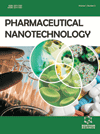
Full text loading...
We use cookies to track usage and preferences.I Understand
Nanoscale drug delivery systems have provoked interest for application in various therapies on account of their ability to elevate the intracellular concentration of drugs inside target cells, which leads to an increase in efficacy, a decrease in dose, and dose-associated adverse effects. There are several types of nanoparticles available; however, core-shell nanoparticles outperform bare nanoparticles in terms of their reduced cytotoxicity, high dispersibility and biocompatibility, and improved conjugation with drugs and biomolecules because of better surface characteristics. These nanoparticulate drug delivery systems are used for targeting a number of organs, such as the colon, brain, lung, etc. Pulmonary administration of medicines is a more appealing method as it is a non-invasive route for systemic and locally acting drugs as the pulmonary region has a wide surface area, delicate blood-alveolar barrier, and significant vascularization. A core-shell nano-particulate drug delivery system is more effective in the treatment of various pulmonary disorders. Thus, this review has discussed the potential of several types of core-shell nanoparticles in treating various diseases and synthesis methods of core-shell nanoparticles. The methods for synthesis of core-shell nanoparticles include solid phase reaction, liquid phase reaction, gas phase reaction, mechanical mixing, microwave-assisted synthesis, sono-synthesis, and non-thermal plasma technology. The basic types of core-shell nanoparticles are metallic, magnetic, polymeric, silica, upconversion, and carbon nanomaterial-based core-shell nanoparticles. With this special platform, it is possible to integrate the benefits of both core and shell materials, such as strong serum stability, effective drug loading, adjustable particle size, and immunocompatibility.

Article metrics loading...

Full text loading...
References


Data & Media loading...

